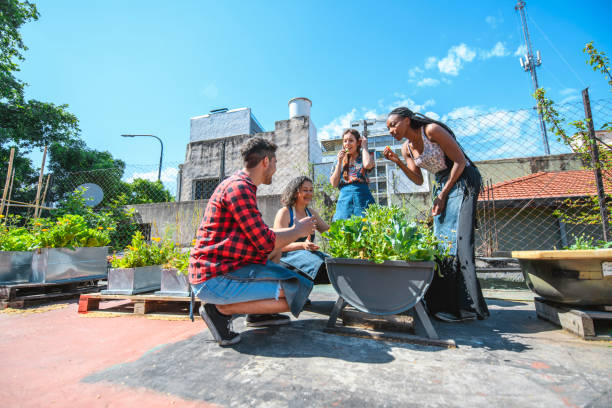
In an increasingly digital world, community gardens are becoming a sanctuary for city dwellers. They foster connection, mental well-being, and sustainability while combatting the loneliness of urban living.
The Growing Need for Connection in Urban Spaces
Urbanization has brought about many benefits, from access to better job opportunities to cutting-edge healthcare and vibrant cultural scenes. Yet, the rapid growth of cities has also resulted in a growing sense of isolation for many. City dwellers often find themselves disconnected from nature, their neighbors, and sometimes, even themselves.
In densely populated areas, it’s easy to feel lost in the crowd. People are busier than ever, with technology providing constant distraction but very little face-to-face interaction. This emotional detachment can lead to mental health issues like anxiety, depression, and loneliness. But amidst the concrete jungles of cities, something beautiful is emerging—community gardens. These green spaces are sprouting up in urban neighborhoods as people reclaim the land and transform it into a place of connection, community, and collective well-being.
Community gardens are proving to be more than just a patch of greenery; they are becoming a lifeline for urban residents. These gardens are not only helping to combat the physical lack of green spaces but also addressing the deep psychological need for human interaction and connection.
The Power of Plants: How Community Gardens Promote Social Bonds
1. Fostering Community and Collaboration
One of the most significant benefits of community gardens is their ability to bring people together. In cities where residents are often too busy or disconnected from their neighbors, these gardens offer a common ground for people to meet, collaborate, and share experiences.
In community gardens, everyone—from families to retirees—can take part in cultivating the land. Whether it’s planting vegetables, maintaining flower beds, or learning new gardening techniques, these shared tasks promote teamwork and strengthen bonds between individuals. This sense of shared purpose creates a welcoming atmosphere where people can form friendships, share stories, and build support networks.
For example, in a community garden in New York City, a diverse group of people from different cultural backgrounds come together each weekend to work on the garden and enjoy each other’s company. These connections not only enhance their sense of belonging but also help combat the loneliness that many city residents feel.
2. Providing a Sense of Ownership and Pride
Another powerful aspect of community gardens is that they provide a sense of ownership and pride for the individuals who participate. Having a shared responsibility for maintaining the garden fosters a deeper emotional connection to the space. People invest time and energy into cultivating the land, and in return, they witness the fruits of their labor.
Whether it’s harvesting fresh vegetables or simply enjoying the beauty of a blooming flower bed, these tangible rewards serve as reminders that the garden is not just a plot of land—it’s a place where people come together, contribute, and see the direct impact of their efforts. This feeling of accomplishment can be incredibly satisfying, and it can also serve as an antidote to the feelings of insignificance that often come with urban isolation.

Mental and Physical Health Benefits of Community Gardens
1. Reducing Stress and Improving Mental Health
Gardening has long been known for its therapeutic qualities, and community gardens are no exception. Studies have shown that spending time in nature can significantly reduce stress levels and improve mental well-being. In an urban setting, the calming influence of plants and greenery offers a much-needed escape from the hustle and bustle of city life.
Research suggests that interacting with plants can lower cortisol levels—the hormone responsible for stress—while also boosting serotonin and dopamine, the brain’s “feel-good” chemicals. For individuals living in cities, where the constant noise and fast-paced lifestyle can take a toll on mental health, community gardens serve as a sanctuary, providing a peaceful, restorative environment.
Additionally, the act of gardening itself encourages mindfulness and presence. It requires focus and patience, allowing individuals to slow down and engage with the earth. These calming activities are particularly valuable in an age where technology and distractions constantly pull our attention away from the present moment.
2. Encouraging Physical Activity and Healthy Eating
Community gardens also promote physical health by encouraging exercise and providing access to fresh, healthy food. Gardening is a form of low-impact physical activity that improves strength, flexibility, and cardiovascular health. Tasks such as planting, weeding, and harvesting offer a gentle workout that is suitable for people of all ages and fitness levels.
Moreover, community gardens are an excellent source of fresh produce. For individuals who may not have access to healthy, affordable food options in urban environments, these gardens provide an opportunity to grow their own fruits and vegetables. This access to fresh, organic food helps individuals adopt healthier eating habits, reducing their dependence on processed foods and fast food options.
Community Gardens as Environmental Stewards
1. Greening the City: Environmental Impact
In addition to their social and health benefits, community gardens play a vital role in improving the urban environment. Cities often suffer from a lack of green spaces, which can lead to air pollution, reduced biodiversity, and increased urban heat islands. Community gardens help address these issues by transforming vacant lots or underused urban areas into green havens.
Plants in community gardens improve air quality by absorbing carbon dioxide and releasing oxygen. They also help reduce the heat island effect by cooling the surrounding environment, making the city more comfortable and livable. Moreover,
community gardens can promote biodiversity by providing a habitat for insects, birds, and other wildlife in urban areas that would otherwise lack these natural spaces.
2. Sustainable Practices and Local Food Systems
Community gardens also encourage sustainable agricultural practices, such as composting, rainwater harvesting, and organic gardening techniques. By adopting these environmentally-friendly methods, community gardens are not only producing food but also teaching urban residents about sustainable living.
In many cities, community gardens are a hub for discussions on food sovereignty and local food systems. They highlight the importance of growing food locally, reducing food waste, and supporting environmentally conscious agriculture. By making sustainability a key focus, community gardens help foster a sense of environmental responsibility among urban residents.
Conclusion: A Pathway to Rebuilding Urban Connections

Community gardens are proving to be much more than just a way to grow food—they are a vital tool in combating urban isolation, promoting mental and physical health, and fostering community ties. By providing a space for individuals to come together, share experiences, and contribute to something meaningful, these gardens are helping to heal the social fabric of urban life.
As cities continue to grow, the need for spaces where people can connect, engage, and take part in hands-on, communal activities will only become more important. Community gardens offer a unique solution to the challenges of urban living, and their role in promoting connection and sustainability will undoubtedly continue to expand in the years to come.
Q&A: The Role of Community Gardens in Combating Urban Isolation
Q: How do community gardens help combat urban isolation?
A: Community gardens bring people together by providing a space for social interaction, collaboration, and shared activities. They foster a sense of belonging, allowing individuals to connect with their neighbors and build meaningful relationships.
Q: What mental health benefits do community gardens offer?
A: Community gardens reduce stress by offering a peaceful, natural environment. Gardening promotes mindfulness, reduces cortisol levels, and boosts serotonin and dopamine, which can improve mental well-being and overall mood.
Q: How can community gardens improve physical health?
A: Gardening is a form of low-impact physical activity that improves strength, flexibility, and cardiovascular health. Additionally, community gardens provide access to fresh, healthy food, promoting better nutrition and lifestyle habits.
Q: What environmental benefits do community gardens provide?
A: Community gardens help reduce urban heat islands, improve air quality, and promote biodiversity by providing green spaces in cities. They also encourage sustainable agricultural practices like composting and organic farming.
Q: How do community gardens contribute to sustainability?
A: Community gardens promote sustainability by teaching residents how to grow food locally, reduce food waste, and adopt eco-friendly practices such as rainwater harvesting and composting. They foster a culture of environmental responsibility.